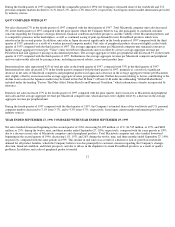Apple 1997 Annual Report Download - page 24
Download and view the complete annual report
Please find page 24 of the 1997 Apple annual report below. You can navigate through the pages in the report by either clicking on the pages listed below, or by using the keyword search tool below to find specific information within the annual report.In August 1997, the Company and Microsoft entered into patent cross licensing and technology agreements. Under these agreements, the
companies provided patent cross licenses to each other. In addition, for a period of five years from August 1997, Microsoft will make future
versions of its Microsoft Office and Internet Explorer products for the Mac OS, and the Company will bundle the Internet Explorer product
with Mac OS system software releases and make that product the default Internet browser for such releases. In addition, Microsoft purchased
150,000 shares of Apple Series 'A' non-voting convertible preferred stock for $150 million. While the Company believes that its relationship
with Microsoft will be beneficial to the Company and to its efforts to increase the installed base for the Mac OS, the Microsoft relationship is
for a limited term and does not cover many of the areas in which the Company competes with Microsoft, including the Windows platform. In
addition, the Microsoft relationship may have an adverse effect on, among other things, the Company's relationship with other partners. There
can be no assurance that the benefits to the Company of the Microsoft relationship will not be offset by the disadvantages.
SUPPORT FROM THIRD-PARTY SOFTWARE DEVELOPERS
Decisions by customers to purchase the Company's personal computers, as opposed to Windows-based systems, are often based on the
availability of third-party software for particular applications. The Company believes that the availability of third-
party application software for
the Company's hardware products depends in part on third-party developers' perception and analysis of the relative benefits of developing,
maintaining, and upgrading such software for the Company's products versus software for the larger Windows market. This analysis is based
on factors such as the perceived strength of the Company and its products, the anticipated potential revenue that may be generated, and the
costs of developing such software products. To the extent the Company's recent financial losses and declining demand for the Company's
products, as well as the Company's decision to wind down its Mac OS licensing program, have caused software developers to question the
Company's prospects in the personal computer market, developers could be less inclined to develop new application software or upgrade
existing software for the Company's products and more inclined to devote their resources to developing and upgrading software for the larger
Windows market. Moreover, the Company's current plan to introduce a new operating system (code named "Rhapsody") could cause software
developers to stop developing software for the current Mac OS. In addition, there can be no assurance that software developers will decide to
develop software for the new operating system on a timely basis or at all.
Microsoft is an important developer of application software for the Company's products. Although the Company has entered into a relationship
with Microsoft, which includes Microsoft's agreement to develop and ship future versions of its Microsoft Office and Internet Explorer
products and certain other Microsoft tools for the Mac OS, such relationship is for a limited term and does not cover many areas in which the
Company competes with Microsoft. Accordingly, Microsoft's interest in producing application software for the Mac OS not covered by the
relationship or upon expiration of the relationship may be influenced by Microsoft's perception of its interests as the vendor of the Windows
operating system.
GLOBAL MARKET RISKS
A large portion of the Company's revenue is derived from its international operations. As a result, the Company's consolidated operations and
financial results could be significantly affected by risks associated with international activities, including economic and labor conditions,
political instability, tax laws (including U.S. taxes on foreign subsidiaries), and changes in the value of the U.S. dollar versus the local currency
in which the products are sold.
Countries in the Asia Pacific region, including Japan, have recently experienced weaknesses in their currency, banking and equity markets.
These weaknesses could adversely affect consumer demand for the Company's product, the U.S. dollar value of the Company's foreign
currency denominated sales, the
21
























